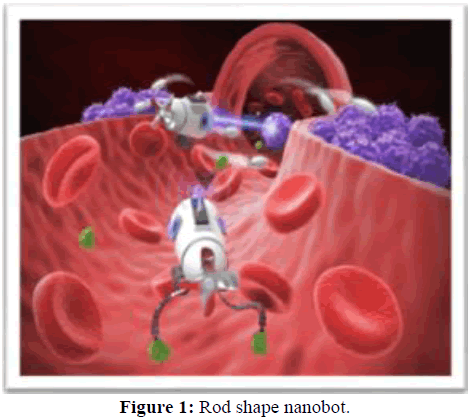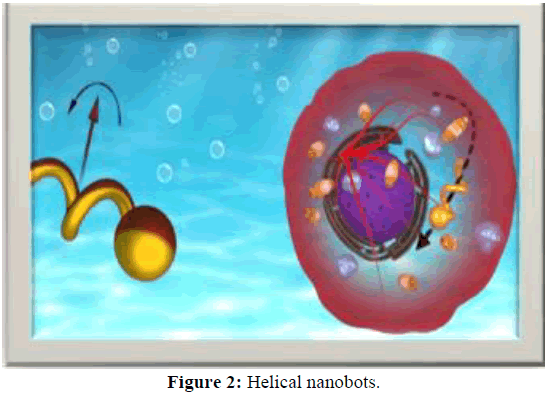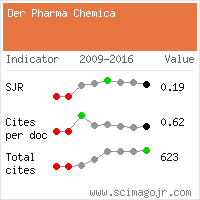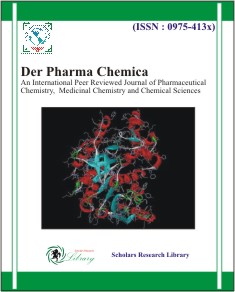Review Article - Der Pharma Chemica ( 2025) Volume 17, Issue 1
Harnessing Nanobots for Early Detection and Targeted Treatment of Cancer
Ashvini Shinde*Ashvini Shinde, Department of Pharmacognosy, Nalanda College of Pharmacy, Cherlapally, Nalgonda, Telangana, India, Email: ashvini4213@gmail.com
Received: 30-Sep-2024, Manuscript No. DPC-25-159786; Editor assigned: 03-Oct-2024, Pre QC No. DPC-25-159786 (PQ); Reviewed: 17-Oct-2024, QC No. DPC-25-159786; Revised: 01-Feb-2025, Manuscript No. DPC-25-159786 (R); Published: 28-Feb-2025, DOI: 10.4172/0975-413X.17.1.621-624
Abstract
Because they can deliver therapeutic agents efficiently and precisely, nanobots have become a promising technique in the treatment of cancer. Recent developments in the design, construction and use of nanobots in cancer treatment are highlighted in the study. Many tumours are very challenging to detect and diagnose. The management of cancer depends on the creation of novel, extremely sensitive, effective diagnostic and therapeutic techniques. The negative consequences of current therapies, such as damage from conventional chemotherapy, may be lessened if nanorobots are able to deliver and deliver large quantities of anti-cancer drugs to cancerous cells while preserving healthy cells. As nanotechnology advances, nanobots are increasingly being used in cancer detection and therapeutic treatment. By employing nanorobotic technology, the medication can be directed to a specific site, enhancing its effectiveness and minimizing the likelihood of side effects.
Keywords
Biosensor; Nanorobotcic; Nanobots; Targeted drug delivery; Cancer therapy
Introduction
People of all socioeconomic levels, regardless of age, including adults and children, are susceptible to the terrible disease known as cancer. Hippocrates coined the term "cancer" and proposed a theory involving four bodily fluids: Blood, phlegm, yellow bile and black bile. Specifically, he suggested that an accumulation of black bile leads to the formation of cancer. With over 7.6 million deaths each year or 13% of all deaths, this disease is one of the leading causes of death worldwide. According to projections, the number of deaths from cancer could increase to 13.1 million by 2030. It is critical to realise that cancer is not a single illness, but rather a collection of illnesses, each with unique traits that impact various organs or systems. Medicinal nanorobots are nanoscale structures without set measurements that are equipped with engines that can convert different forms of energy into mechanical movement. These devices are intended to carry out medicinal tasks at the cellular level. Because of their small size, they can engage in direct interactions with cells and even enter them to gain access to cellular machinery. Finding and destroying cancer cells is one of the main functions of nanorobotics in cancer treatment. Another is the use of chemical biosensors to quickly identify tumour cells in a patient's body. Nanorobots have the potential to repair damaged DNA cells, effectively eliminate cancer cells and assist in removing blockages in blood arteries. Researchers have determined that factors such as lifestyle changes, dietary habits, environmental influences and the growth of various industries contribute to the increasing incidence of cancer by heightening exposure to radiation and carcinogens. Advances in nanotechnology have significantly expanded medical treatments, with DNA nanobots now being used to detect different types of cancer cells. This review article focuses on highlighting the importance, functionality, types and applications of nanorobots, particularly in the field of DNA-based cancer therapies [1].
Types of nanobots in cancer treatment
Different types of nanobots in cancer treatment they are shown in a chart:
Rod shape nanobots: Rod-shaped nanobots are being used in cancer treatment because of their ability to avoid phagocytosis, circulate longer and accumulate in tumors (Figure 1).
Helical nanobots: Helical nanorobots have a spiral structure and are equipped with magnetic materials. Their helical design not only defines their shape but also allows movement along the spiral axis [2]. These nanorobots hold the potential to deliver anticancer drugs directly to tumor cells, minimizing damage to healthy cells. Moreover, they can play a crucial role in detecting tumor cells in the early stages of cancer (Figure 2).
Spherical shape nanobots: Spherical nanoparticles and nanorobots offer great promise for cancer therapy because of their beneficial optical properties and biocompatibility. Spherical Gold Nanoparticles (AuNPs), in particular, can convert light into heat, making them effective in targeting and destroying tumor cells.
Disk shaped nanobots: Disk-shaped magnetic particles can be heated using external magnetic fields, generating heat that helps destroy cancer cells. Nanobots can deliver anticancer drugs directly into diseased cells while avoiding harm to healthy cells. The shape of nanoparticles can be tailored to improve their circulation, enhance tumor penetration and boost cellular uptake [3].
Literature Review
Materials used in nanobots for cancer treatment
To optimize their functionality, biocompatibility and therapeutic effectiveness, nanobots used in cancer treatment are typically made from a variety of materials. Commonly used materials include: Biodegradable polymers like Polylactic Acid (PLA) and Polyethylene Glycol (PEG), which can safely degrade within the body; gold nanoparticles, known for their unique optical properties, enabling targeted drug delivery and enhanced imaging techniques; silica nanoparticles, often used in drug delivery systems due to their porous structure, which allows for encapsulation of therapeutic agents; carbon-based materials, such as carbon nanotubes and graphene, which can enhance drug delivery and offer potential photothermal effects; liposomes, phospholipid-based vesicles that encapsulate drugs, improving their delivery to tumor sites; magnetic nanoparticles, useful for targeted drug delivery and imaging, as they can be controlled by external magnetic fields; dendrimers, highly branched synthetic macromolecules that transport drugs and target specific cells; and hydrogels, water-swollen networks that encapsulate drugs and release them in a controlled manner. These materials can be tailored to have specific characteristics, such as size, surface charge and functionalization, to improve targeting precision and minimize side effects in cancer therapy [4].
Current therapy of cancer
Stem cell therapy: Stem cell therapy utilizes undifferentiated cells found in the bone marrow, which have the potential to transform into various cell types in the body. This treatment approach is considered both safe and effective for cancer therapy. However, the use of stem cells is still primarily in the clinical trial phase, as ongoing research explores their potential for regenerating damaged tissues. At present, mesenchymal stem cells are being tested in trials focused on bone marrow delivery, as well as in studies involving adipose and connective tissues [5].
Pluripotent stem cells: Embryonic Stem Cells (ESCs) are derived from the inner cell mass of the embryo and have the ability to differentiate into nearly all cell types, except for those that form the placenta. A major breakthrough in cell biology came in 2006 with Yamanaka's discovery, which showed that Pluripotent Stem Cells (iPSCs) could be generated from human cells outside the body. To address ethical concerns surrounding embryo manipulation, iPSCs are often co-cultured with ESCs. Currently, Hematopoietic Embryonic Stem Cells (HESCs) and iPSCs are being used to boost the activity of effector T cells and Natural Killer (NK) cells, as well as to enhance antibody production [6].
Adult stem cells: Adult Stem Cells (ASCs) used in cancer therapy primarily include Hematopoietic Stem Cells (HSCs), Mesenchymal Stem Cells (MSCs) and Neural Stem Cells (NSCs). The U.S. Food and Drug Administration (FDA) has approved the use of hematopoietic stem cells derived from umbilical cord blood for treating conditions like multiple myeloma and leukemia. Mesenchymal stem cells, found in various tissues and organs, play a crucial role in the repair and regeneration of cells such as bone cells, adipocytes and chondrocytes. The distinctive biological properties of MSCs may offer a complementary approach alongside other cancer treatments.
Cancer stem cells: Cancer Stem Cells (CSCs) originate from epigenetic changes in normal stem cells or progenitor cells. They play a significant role in cancer treatment by influencing tumor growth, metastasis and recurrence, making them a promising therapeutic target. Stem cells are involved in various aspects of tumor treatment. One key mechanism is the rehoming process, where Hematopoietic Stem Cells (HSCs) rapidly migrate to stem cell-rich areas in the bone marrow, where they engraft and generate specialized cells. This process is driven by interactions between stem cell receptors and endothelial cells. Another crucial mechanism is tumor tropism, where mesenchymal stem cells are attracted to the Tumor Microenvironment (TM), contributing to the development of tumor stroma through differentiation [7].
Discussion
Challenges
Biocompatibility and toxicity: The metals, polymers and synthetic materials used in the production of nanobots have the potential to trigger immune responses and cause toxicity. As a result, long-term safety and possible side effects remain significant concerns.
Efficient delivery: Delivering nanobots to deep-seated tumors or those in hard-to-reach areas presents significant challenges. Barriers like the body's immune system, the vascular system and the dense tumor microenvironment make it nearly impossible to deliver the tiny nanobots with complete efficiency.
Control and guidance: Controlling and guiding nanobots within the human body remains a long-term challenge. While there has been some preliminary success using magnetic fields or chemical gradients, achieving true real-time control in the dynamic environment of the human body is still a distant goal.
Clearance and persistence: After a nanobot has achieved its assigned task, it must be cleared out of the body. Such nanobots must be designed such that once they have completed their mission, either they biodegrade safely or are actively removed to avoid accumulation and long-term effects [8].
Production and scalability: Mass production of nanorobots for clinical applications remains a significant logistical challenge. Achieving the production of nanobots in large quantities with the required precision and consistency has not yet been realized, particularly for widespread clinical use. Additionally, the development, testing and manufacturing of nanobots are costly. Reducing these costs without compromising their effectiveness, safety or potential for use in resource-limited settings is a crucial goal.
Future direction of nanobots
Advanced targeting method: Research focuses on the development of targeting mechanisms to improve treatment accuracy. One of these mechanisms is the use of ligands selectively binding to the bio marker of the cancer.
Multifunctional nanobots: In the future there may be nanobots that combine gene therapy, immunotherapy and chemotherapy for the delivery of numerous therapeutic molecules at the same time.
Real-time monitoring: By including biosensors or imaging technologies in nanorobots, the efficacy of therapy and tumor response can be monitored in real-time [9].
Personalized medicine: Nanorobotic therapies can be tailored to each patient's unique tumor profile to increase efficacy and minimize adverse effects.
Combined treatment: For example, searching for applying nanobot in collaboration with immunotherapy or radiation therapy may improve global treatment results.
Ethical and regulatory frameworks: As nanobot technology moves closer to clinical application, it will be essential to establish explicit ethical principles and regulations [10].
Clinical trials: Additional funding will be needed for clinical trials to evaluate the safety and efficacy of nanorobot therapies in various types of cancer.
Conclusion
Nanorobots with enhanced detection capabilities could significantly speed up cancer diagnosis. These nanobots would respond to acoustic signals, receive programming instructions through external sound waves and transmit the data they gather. Programmed to detect various cancer biomarkers such as E-cadherins and beta-catenin, they can deliver targeted therapy at both the primary and metastatic stages of cancer. The key advantage of nanorobots is their ability to provide precise, targeted treatment. Nanotechnology can also be applied for cancer biomarker detection, including protein detection, circulating tumor DNA detection, microRNA detection, DNA methylation detection, extracellular vesicle detection, cell surface protein detection and mRNA-based detection.
References
- Gmeiner WH, Ghosh S. Nanotechnol Rev. 2014; 3(2): p. 111-122.
[Crossref] [Google Scholar] [PubMed]
- Kong X, Gao P, Wang J, et al. J Hematol Oncol. 2023; 16(1): p. 74.
[Crossref] [Google Scholar] [PubMed]
- Pathan AA, Deshmukh SP. GSC Biol Pharmaceu Sci. 2023; 25(1): p. 252-260.
- Chattha GM, Arshad S, Kamal Y, et al. J Drug Deliv Technol. 2023; 80: p. 104173.
- Allen TM, Cullis PR. Adv Drug Deliv Rev. 2013; 65(1): p. 36-48.
[Crossref] [Google Scholar] [PubMed]
- Zhang L, Su H, Wang H, et al. Theranostics. 2019; 9(7): p. 1893.
[Crossref] [Google Scholar] [PubMed]
- Lee KY, Mooney DJ. Chem Rev. 2001; 101(7): p. 1869-1880.
[Crossref] [Google Scholar] [PubMed]
- He W, Ma G, Shen Q, et al. Nanomaterials. 2022; 12(10): p. 1738.
[Crossref] [Google Scholar] [PubMed]
- Goiriena-Goikoetxea M, Muñoz D, Orue I, et al. App Phy Rev. 2020; 7(1).
- Li J, Dekanovsky L, Khezri B, et al. Cyborg Bionic Sys. 2022.
[Crossref] [Google Scholar] [PubMed]





